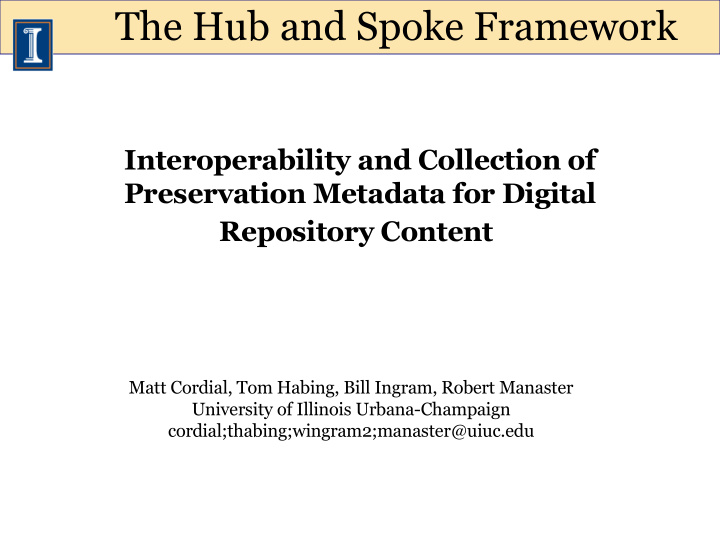



The Hub and Spoke Framework Interoperability and Collection of Preservation Metadata for Digital Repository Content Matt Cordial, Tom Habing, Bill Ingram, Robert Manaster University of Illinois Urbana-Champaign cordial;thabing;wingram2;manaster@uiuc.edu
Outline • Conceptual Overview – Conceptual diagrams – Framework architecture • Components – METS Profiles (The Hub) – Content processing, transformation, and metadata generation (Spokes) – Facilitating repository ingestion and dissemination (The Handoff) • Conclusion – Finding more information
A Birds-eye View
The Essentials • Extensible METS profile • Repository specific processing and transformation utilities • Java API for local integration and extensibility – Apache XML Beans • Dissemination/Submission Web-service – RESTful
DSpace EPrints ... LRCRUD Service Dspace LRCRUD EPrints LRCRUD Service ... Service LRCRUD Client Dspace Workflow EPrints Workflow ... Workflow Manager JHOVE Dspace Packager EPrints Packager ... Packager Web Profile API ... ... Hub and Spoke METS Profile API Apache XMLBeans
Functional Overview Technical Metadata METS Processing and Handoff Repository Augmentation Profiles Transformation TechMD METS Augmenter Construction Web Service Descriptive Metadata Client Augmentation JHOVE Bitstream Web Service Verification XSLT Profile Validation to hub from hub
METS Profiles • Non-prescriptive in regards to structure or file formats • Intended to overlay other profiles which specify case-specific needs (i.e. web captures) • PREMIS • MODS – Must conform to the DLF Aquifer profile • File-format specific technical metadata – MIX, VIDEOMD, AUDIOMD, others as appropriate
Functional Overview Technical Metadata METS Processing and Handoff Repository Augmentation Profiles Transformation TechMD METS Augmenter Construction Web Service Descriptive Metadata Client Augmentation JHOVE Bitstream Web Service Verification XSLT Profile Validation to hub from hub
Technical Metadata Generation/Augmentation • JHOVE Output + Custom XSLT • Java “Applicators” for specific technical metadata schemas – MIX – TEXTMD – AUDIOMD – PREMIS – Class hierarchy to support new Applicators
Functional Overview Technical Metadata METS Processing and Handoff Repository Augmentation Profiles Transformation TechMD METS Augmenter Construction Web Service Descriptive Metadata Client Augmentation JHOVE Bitstream Web Service Verification XSLT Profile Validation to hub from hub
To-Hub Processing Generate/collect provenance metadata Data Store / DIPs Hub Extract format- specific technical metadata Generate/collect digital provenance metadata Embed links to digital items image.jpg Model structure of the item Embed native metadata Transform/enrich native metadata.xml metadata
From-Hub Generate provenance metadata Processing SIPs Hub Transform hub metadata to repository-compatible metadata Assemble into packages for repository ingest Add the METS file as metadata.xml an item in the submission package hubMets.xml
Functional Overview Technical Metadata METS Processing and Handoff Repository Augmentation Profiles Transformation TechMD METS Augmenter Construction Web Service Descriptive Metadata Client Augmentation JHOVE Bitstream Web Service Verification XSLT Profile Validation to hub from hub
LRCRUD • Packages usable by a repository’s native ingestion routines • REST Web-Service – Client integrated into processing workflow – DSpace, EPrints, and others in the next year – Specification and API to create service for other repository systems
GET /dspace-lrcrud/2135.89342 HTTP/1.1 LRCRUD Client 1 • Client submits a GET request to LRCRUD service for a specific item • Service calls the 2 Zip File native DSpace LRCRUD dissemination Service 4 DSpace native request for handle 2135.89342 routine • Service receives the output from the dissemination, creates a header file, and adds both the Item + header file and the metadata disseminated content to a zip-file 3 Data • Service returns a zip- file containing the package to the client Repository Server
Create stub record LRCRUD Client 2) Client issues a POST request to 5 LRCRUD specifying “where” to create 1 Zip File the record (e.g. communities or HTTP Status 201 collections) if needed PUT Location header w/ 8 Fedora ID Fedora ID POST 3) LRCRUD calls the native Fedora HTTP/1.1 /fedora-lrcrud/ HTTP Status 204 creation routine 4 HTTP/1.1 4) Fedora supplies LRCRUD with the ID for the newly created record 5) LRCRUD responds to the client with an LRCRUD HTTP 201 “Created” message and Service returns the ID in the Location: header Upload and ingest the item 2 6 8) Client issues a PUT request to Request creation Fedora ID Confirmation of stub record LRCRUD to replace the package 3 identified by the URI. The entity body of the request must contain the zip-file 7 containing the package to be ingested. Item + metadata 9) LRCRUD unpacks the files and calls the native Fedora ingestion routine. 10) Fedora tells LRCRUD that ingestion was successful Data 11) LRCRUD responds to the client with an HTTP 204 “No Content” message indicating that the request was successful. Repository Server
More Information Open Source Code: http://sourceforge.net/projects/echodep LRCRUD Service Specification: http://dli.grainger.uiuc.edu/echodep/hns/LRCRUDS.htm METS Profiles: Generic - http://www.loc.gov/standards/mets/profiles/00000015.xml Web Capture - http://www.loc.gov/standards/mets/profiles/00000016.xml Java API Documentation (Javadoc): http://echodep.sourceforge.net/javadoc/index.html Project Web Site http://ndiipp.uiuc.edu/
Questions? Matt Cordial cordial@uiuc.edu
Recommend
More recommend